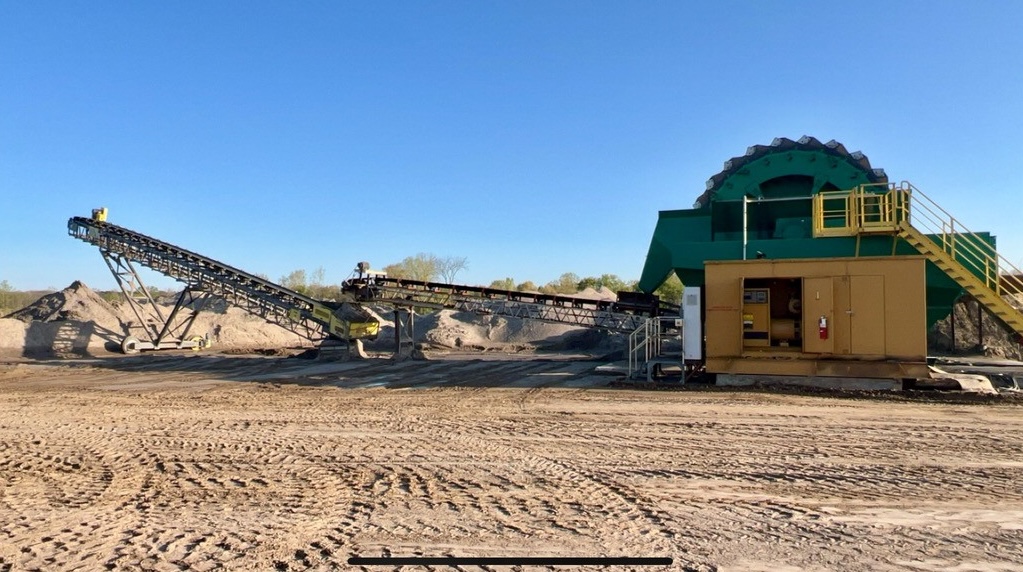FROM THE FIELD
Revolutionizing Dredging: The Power of the Bucket Wheel
Improving operational efficiency with proven technology.

At The Gerken Companies, we are continually seeking innovative solutions to enhance efficiency, reduce costs, and minimize our environmental impact. In 2019, we encountered a significant challenge: how to effectively dewater massive volumes of material from our Damon Cutter Chain Dredge. In this installment of From the Field, we relate the story of addressing that challenge using a technology with roots dating back nearly a century—the Bucket Wheel.
To provide some context, the Damon Dredge system features a massive 90,000-pound, 85-foot ladder with a cutter chain resembling an oversized chainsaw. Once the cutter chain dislodges material, a 14-inch suction pipe and pump, powered by a 750-horsepower motor, transports the material up the pipe to distances exceeding 1,500 feet. With the dredge capable of sending 7,000 gallons per minute of slurry (a mixture of gravel and water) through the pipe, finding an appropriate unit on the receiving end to dewater and manage that quantity posed a significant challenge.
After thorough research, we concluded that the Bucket Wheel offered the most effective balance in efficiency and maintenance. Despite its modern applications, the technology is not new; the use of Bucket Wheels for dewatering and classification dates back to the 1920s. In particular, we focused on the German manufacturer Stichweh, which debuted its first Bucket Wheel model in 1962.
The selection process was not without its hurdles. Given the limitations imposed by COVID-19, an on-site evaluation was out of the question. Nevertheless, we meticulously analyzed factors like gradation, fuel consumption, and cost per ton. Ultimately, we chose the 6514 H model, a bucket wheel that operates with an efficient 25-horsepower electric motor.
Here are some key specifications of the Stichweh 6514 H Bucket Wheel:
- Service Weight: 333,000 lbs
- Solids Capacity: 700 tons per hour
- Slurry Capacity: 8,800 gallons per minute
- Wheel Diameter: 21 ft 4 in
- Wheel Width: 4 ft 8 in
- Number of Buckets: 48
- Power: 25 HP electric motor
- Fuel Consumption: Approximately 7 gallons per hour
How It Works
As slurry flows into the receiving box, it moves at an impressive speed of 17 feet per second. The mixture of gravel and sand settles at the bottom, while water rises and is discharged through an overflow pipe into a settling pond, ultimately returning clean to the main lake.

The speed of the wheel is finely tuned by load-sensing technology, adapting to material intake—allowing rotation from as slow as 0.5 revolutions per minute to 1.5 revolutions per minute. The innovative design features 48 urethane-lined buckets with tiny slots—the size of a dime—allowing water to escape easily while efficiently transporting the solid material to a transfer conveyor.
Since integrating the Bucket Wheel into our processes, we have seen remarkable improvements, reinforcing our commitment to efficiency and innovation in dredging operations.
“The success at our primary location led us to acquire a second wheel from Custom Dredge Works for our Hillsdale site,” says Todd A Crane, Michigan Operations Manager. “And we have had the same success.”
Conclusion
Use of the Bucket Wheel showcases the significance of combining traditional methods with modern engineering. With its impressive capabilities and simplicity, the Bucket Wheel not only addresses our operational challenges but also stands as a testament to the ingenuity of engineering solutions throughout history.
The Power of the Bucket Wheel
The technology used in Bucket Wheels dates back to the 1920s.

